Nestled in the heart of Osaka, the centuries-old Shitennoji stands as a testament to Japan’s rich cultural heritage. Established in 593 by Prince Shotoku, this temple has endured the test of time, captivating visitors with its serene gardens, intricate architecture, and profound spiritual significance. Explore the temple’s history and uncover the lasting impact of Prince Shotoku’s devotion to Buddhism. Enjoy the tranquility of the pagodas and ponds, and discover why Shitennoji remains one of the most revered temples in the country.
Key Points
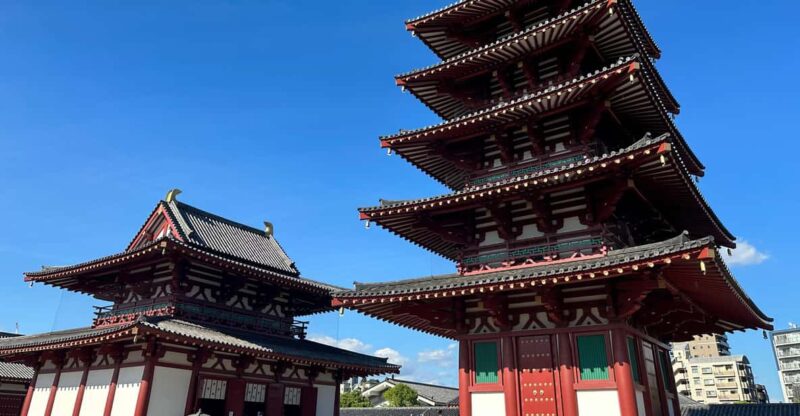
- Shitennoji is one of the oldest temples in Japan, established in 593 CE by Prince Shotoku, a key figure in the introduction of Buddhism.
- The temple complex features impressive architectural marvels, including the main hall, paradise hall, and a 45-meter-tall five-story pagoda.
- The tranquil Honbou Japanese Garden within the complex offers serene ponds, manicured landscapes, and viewpoints showcasing the stunning temple buildings.
- Visitors can experience Shitennoji’s spiritual significance through guided meditations, rituals, and interactions with resident monks, reflecting on the principles of Mahayana Buddhism.
- While not as widely visited as some other famous temples in Japan, Shitennoji provides a glimpse into the country’s rich Buddhist heritage and the legacy of Prince Shotoku.
Shitennoji: A Historical Treasure
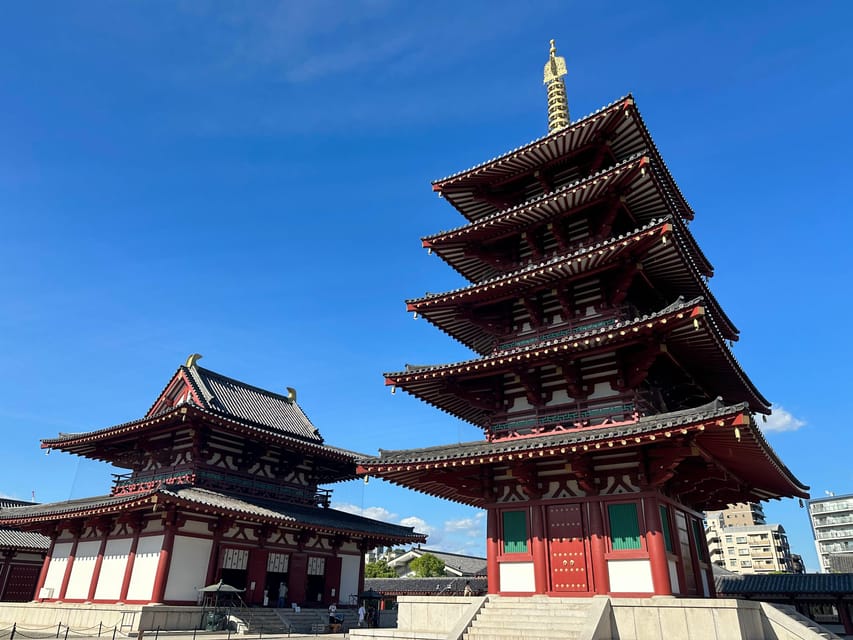
Although Shitennoji may not be as widely visited as some of Japan’s other famous temples, it remains a historical treasure that offers visitors a glimpse into the country’s rich Buddhist heritage. Established in 593 by Prince Shotoku, a pivotal figure in the spread of Buddhism in Japan, Shitennoji is one of the oldest temples in the country.
Its impressive architecture, tranquil gardens, and spiritual significance make it a must-visit destination for those interested in exploring Japan’s deep-rooted Buddhist traditions. Despite its relative obscurity compared to more popular temples, Shitennoji’s enduring historical and cultural value make it a truly remarkable and rewarding experience for those who venture to discover it.
You can also read our reviews of more tours and experiences in Osaka.
Prince Shotoku’s Influential Role
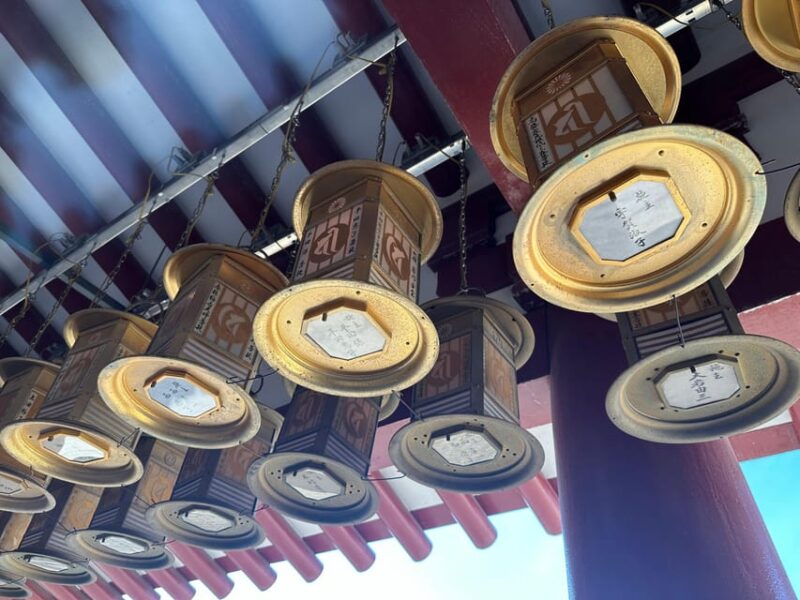
Prince Shotoku’s profound influence on the spread of Buddhism in Japan can’t be overstated. As the founder of Shitennoji, one of the oldest temples in the country, he played a pivotal role in introducing and promoting the Buddhist faith.
Some of his key contributions include:
- Establishing the first Buddhist temple in Japan, Shitennoji, in 593 CE.
- Actively supporting the translation and dissemination of Buddhist scriptures.
- Incorporating Buddhist principles into the governance of the nascent Japanese state.
- Fostering the growth of monastic communities and the development of Buddhist art and architecture.
Shitennoji stands as a testament to Prince Shotoku’s legacy, serving as a revered spiritual center and a symbol of Japan’s rich Buddhist heritage.
Exploring the Tranquil Gardens
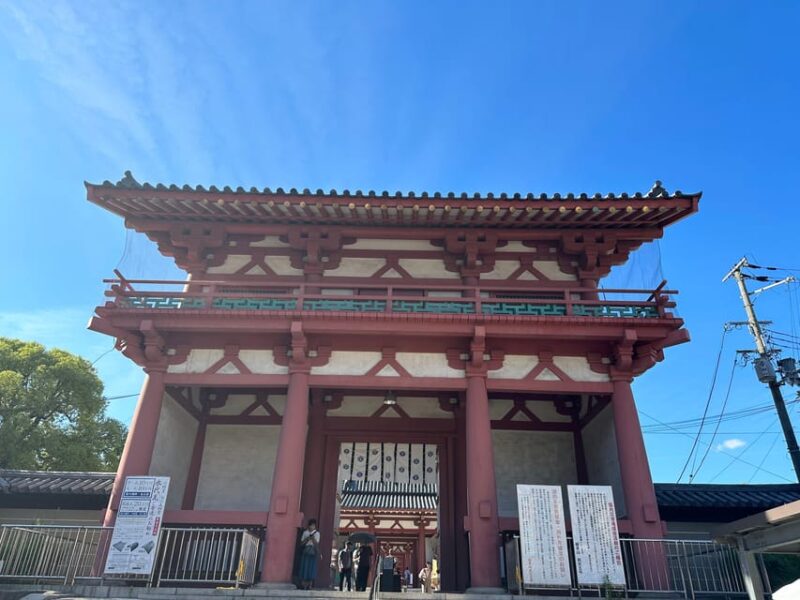
Visitors exploring the temple grounds of Shitennoji are treated to the serene beauty of its tranquil gardens. The Honbou Japanese Garden is a highlight, featuring immaculately manicured landscapes, serene ponds, and pagodas. Guests can wander along the meandering paths, taking in the zen-like atmosphere.
The gardens also offer viewpoints showcasing the stunning architecture of the main temple buildings. Throughout the gardens, visitors encounter the spirituality of Buddhism, with statues and shrines dotting the landscape. Exploring the gardens allows one to escape the bustling streets of Osaka and enjoy the peaceful ambiance that permeates Shitennoji.
Architectural Marvels of Shitennoji
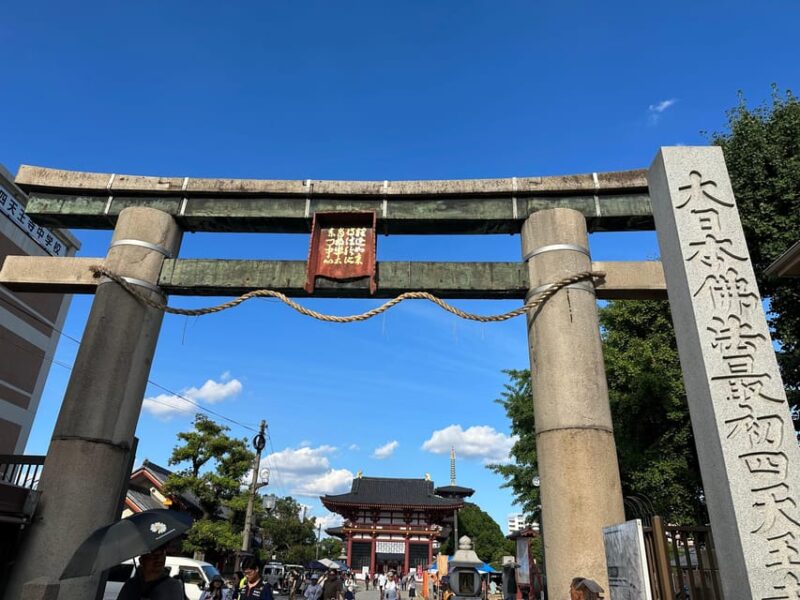
Shitennoji’s architectural marvels captivate visitors as they explore the expansive temple complex. The main hall, known as the Kondo, features an impressive double-eaved roof and intricate carvings.
The Gokuraku-JodoHondo, or Paradise Hall, showcases stunning Buddhist imagery and a gilded interior. The five-story pagoda, standing tall at 45 meters, is a true architectural wonder, with each level representing one of the five elements.
The Shitennoji Museum houses a remarkable collection of cultural artifacts, including ancient scrolls and Buddhist sculptures, providing a glimpse into the temple’s rich history.
- Main Hall (Kondo) with double-eaved roof and intricate carvings
- Paradise Hall (Gokuraku-JodoHondo) with gilded interiors
- Five-story pagoda representing the five elements
- Shitennoji Museum with cultural artifacts and ancient scrolls
Spiritual Significance of the Temple
One can’t fully appreciate Shitennoji without understanding its profound spiritual significance. Established in 593 AD by Prince Shotoku, a devout Buddhist, the temple has been a center of Japanese Buddhism for over 1,400 years.
Its iconic architecture and gardens embody the principles of Mahayana Buddhism, encouraging contemplation and inner peace. Visitors can experience the temple’s spiritual essence through guided meditations, rituals, and interactions with the resident monks.
The temple’s tranquil atmosphere and stunning visual elements invite guests to reflect on the deeper questions of existence. Shitennoji’s enduring legacy as a revered spiritual site continues to inspire and captivate all who step within its hallowed grounds.
Comparison to Other Japanese Temples
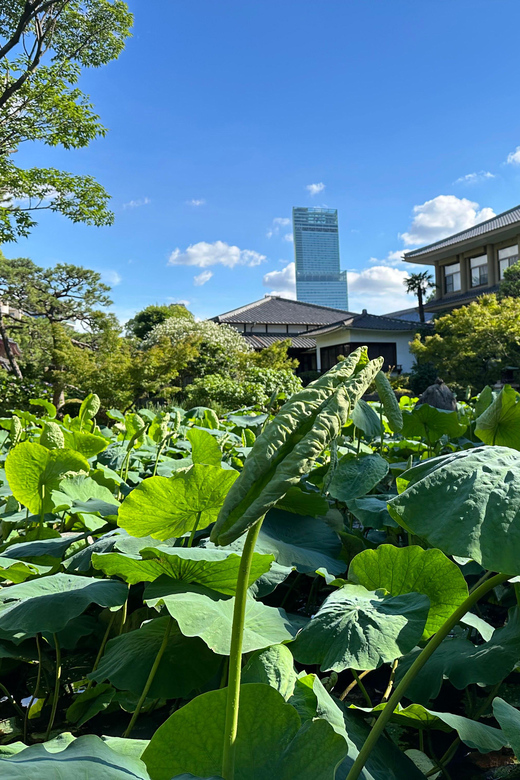
Despite Shitennoji’s profound spiritual significance, it doesn’t attract as many travelers as some other renowned temples in Japan. This is mainly due to its location, which is slightly off the beaten path compared to more centrally located temples like Kiyomizudera in Kyoto or Senso-ji in Tokyo.
Additionally:
- Shitennoji lacks the iconic architecture and immense scale of Japan’s most famous temples.
- It doesn’t have the same level of commercial development, with fewer shops and restaurants nearby to cater to visitors.
- The temple grounds, while serene, don’t offer the same sweeping views or dramatic settings as other popular temple destinations.
- Shitennoji’s historical importance is less widely known among international travelers compared to temples with stronger global recognition.
Tour Duration and Inclusions
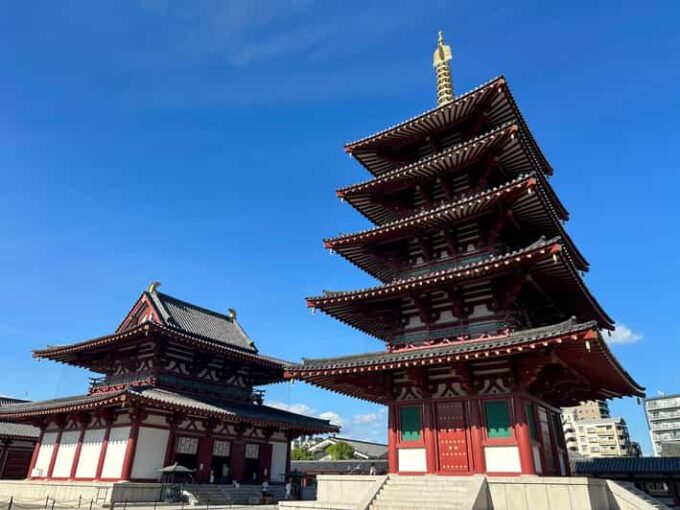
The tour of Shitennoji temple typically lasts between 1 to 1.5 hours, providing visitors an immersive experience to uncover the secrets of this historic site. The private tour is available in both English and Japanese, allowing guests to fully appreciate the temple’s significance.
Included in the tour package are entry tickets to the Central Temple and Honbou Japanese Garden, ensuring visitors can explore the temple’s stunning architecture and serene landscapes. With an expert guide leading the way, the tour highlights the spirituality of Buddhism and the beauty that makes Shitennoji one of Japan’s oldest and most fascinating temples.
Location and Getting There
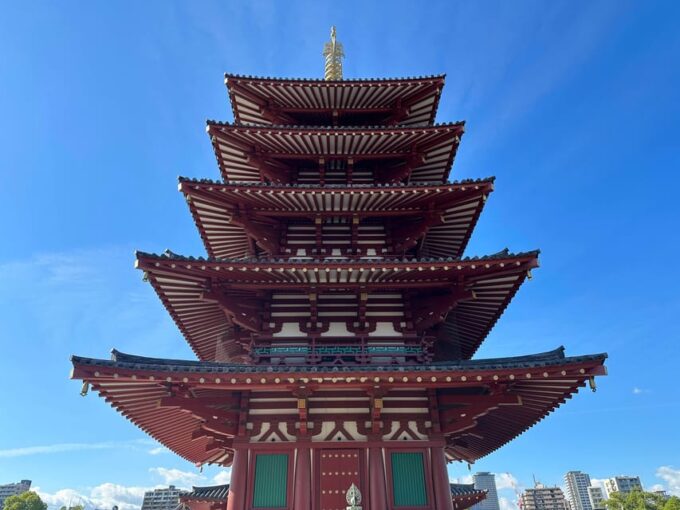
Shitennoji temple is located in the Tennoji ward of Osaka, a bustling city in western Japan. Despite its significance, the temple is less visited by travelers compared to other popular temples in Japan due to its location.
To get there:
- Take the Osaka Loop Line to Tennoji Station.
- From the station, it’s a 10-minute walk to the Shitennoji Ishinotorii (Stone Torii Gate), the starting point of the tour.
- Alternatively, take the Subway Midosuji Line to Shitennoji-mae Yuhigaoka Station, which is just a few minutes’ walk from the temple.
- The temple’s address is 四天王寺1丁目11-18, Tennōji-ku, Ōsaka-shi, Ōsaka-fu 543-0051, Japan.
Frequently Asked Questions
Are Photography and Filming Allowed Inside the Temple?
Photography and filming are generally permitted inside Shitennoji temple, though visitors should be respectful and avoid disrupting the peaceful atmosphere. It’s best to check with the temple staff for any specific rules or restrictions.
Can I Purchase Souvenirs or Incense at the Temple?
Visitors can purchase souvenirs and incense at Shitennoji temple. The temple grounds feature a gift shop and vendor stalls selling traditional Buddhist items, allowing visitors to bring home a piece of the temple’s history and spirituality.
Are There Any Dress Code Requirements to Enter the Temple?
There’s no strict dress code to enter Shitennoji temple, but visitors should wear modest attire that covers shoulders and knees out of respect for the sacred site. Casual, comfortable clothing is acceptable.
Is the Temple Accessible for Visitors With Disabilities?
The temple is generally accessible for visitors with disabilities. Wheelchair-friendly paths and facilities are available, though accessibility may vary across different areas of the temple grounds. It’s best to inquire about specific needs when booking the tour.
Can I Extend the Tour to Visit Nearby Attractions?
Yes, the tour can be extended to visit nearby attractions. Guests can explore additional temples, shrines, or cultural sites in the area to enhance their experience and gain a deeper understanding of the local history and traditions.
Recap
Shitennoji stands as a remarkable testament to Japan’s rich cultural heritage. Established by Prince Shotoku in the 6th century, the temple’s tranquil gardens, impressive architecture, and Mahayana Buddhist principles offer visitors a profound and immersive experience. Shitennoji‘s enduring legacy underscores the lasting impact of Prince Shotoku’s devotion to Buddhism and the temple’s significance in Japan’s historical and spiritual landscape.
You can check if your dates are available here:More Tours in Osaka
- JDM Car Meet Up Tour in Osaka
- Osaka Castle & Dotonbori Lively One-Day Walking Tour
- From Osaka: Private Shirakawa-go and Takayama Tour
- Hidden Gems and Bustling Districts of Osaka Night Tour
- 4/5/6 Hours Private Osaka Tour Designed for Cruise Passengers
- Kyotos Coast Amanohashidate and Ine Boathouse Full-Day Tour
More Tour Reviews in Osaka
Not for you? Here's more things to do in Osaka we have recnetly reviewed
- 2 Best Craft Beer Tours And Tastings In Osaka
- 5 Best Dining Experiences In Osaka
- 2 Best Dinner Tours In Osaka
- 11 Best Cruises And Boat Tours In Osaka
- 25 Best Food Tours In Osaka
- 20 Best Full-Day Tours In Osaka
- 4 Best 2 Day Tours In Osaka
- 2 Best 3 Day Tours In Osaka
- 17 Best Photography Experiences In Osaka
- 3 Best Lunch Experiences In Osaka
- Meet and Fun Chat Osaka Locals With Drink All U Can Party Ticket
- Osaka SAKE Tasting With Takoyaki DIY
